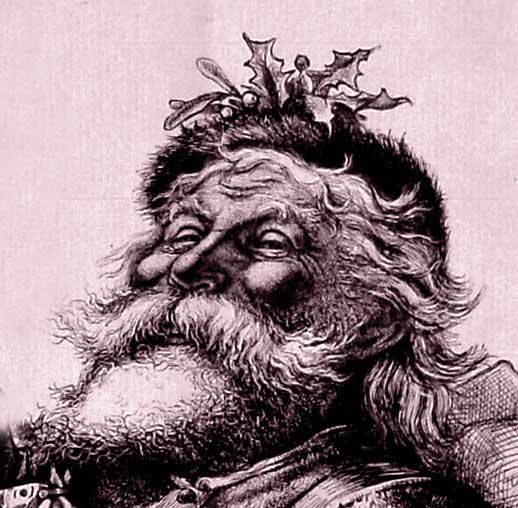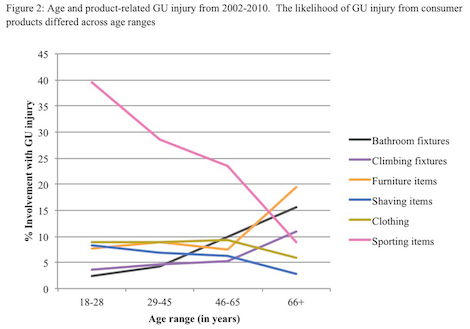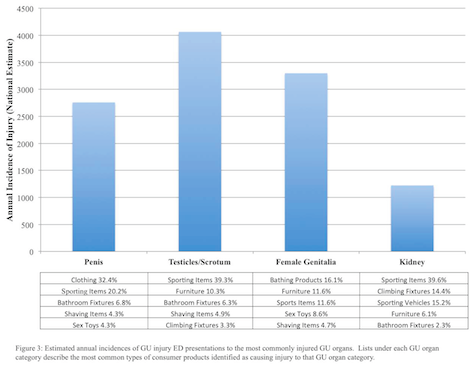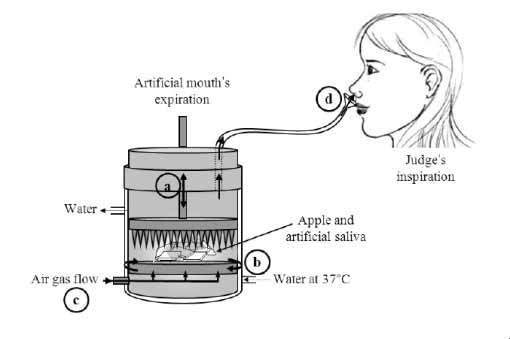Marc Abrahams's Blog, page 530
December 9, 2012
Which Kinds of Products Produce Which Kinds of Genitourinary injuries When
The data in this study indicate that, on a gross society basis, male parts are more often injured by products than are female parts, and that sporting goods are often involved, though more often for younger males than older ones, and that, sporting good aside, zippers are often implicated.
“Product Related Adult Genitourinary Injuries Treated in United States Emergency Departments from 2002 – 2010,” Herman S. Bagga [pictured here, some years ago when he was still in medical school], Gregory E. Tasian, Patrick B. Fisher, Charles E. McCulloch, Jack W. McAninch, Benjamin N. Breyer, Journal of Urology, epub November 2, 2012.
The general picture is discernable when one combines the impact of Figure Two and Figure Three from the study, reproduced here On can also infer that, in general, as people gain decades of experience, they grow more skillful at shaving:
(Thanks to investigator James Harkin for bringing this to our attention.)

December 8, 2012
Fibonacci songs
The Fibonacci series of numbers (1, 1, 2, 3, 5, 8, 13, 21, …) inspired these two songs (and—who knows?—maybe a whole series of others):
(Thanks to investigators Cheryl Bain and Thomas Gallucci for bringing these to our attention.)

December 7, 2012
Domino-stacking in quasi-parallel sheets, with a cat
A rare video of domino-stacking in quasi-parallel sheets, with a cat:
(Thanks to investigator Sip Siperstein for bringing this to our attention.)

Improbable Research dramatic readings at Harvard TODAY
You are invited:
This Is Improbable: Dramatic Readings
When:
Dec 07, 2012 | 3:30 pm - 5:00 pm
Where:
Harvard School of Engineering and Applied Sciences (SEAS), Maxwell Dworkin G115, 33 Oxford Street, Cambridge, Massachusetts
Marc Abrahams and an all-star lineup will do dramatic readings from bizarre studies featured in the book This Is Improbable. Featuring…
Margo Seltzer (prof, Harvard computer science)
Melissa Franklin (chair, Harvard physics)
Mahadevan (Ig Nobel Prize winner in physics, for explaining how sheets wrinkle)
Chris Balliro (meteorologist and Italian basketball star)
Dudley Herschbach (Nobel laureate, chemistry)
Robin Abrahams (“Miss Conduct” columnist, Boston Globe)
Corky White (prof, BU food anthropologist)
Daniel Rosenberg (Ig Nobel performing chemist)
Mary Carmichael (higher ed reporter, Boston Globe)
Gus Rancatore (proprietor, Toscanini’s Ice Cream)
Georgia Lyman (actress and theatrical producer)
Jean Berko Gleason (prof emerita, BU psychology)
others to be announced
Free. The event will begin with a wine and cheese reception hosted by Dean Cherry Murray.
Organizers: Ros Reid, Sandra Klemm, Michael Rutter. [TWITTER: #IgNobel]

Blue Dye Turns Patient Blue
When a medical patient turns blue, it is sometimes possible to identify the cause. Here is a report of one such incidence:
“Adverse Reaction; Patent Blue Turning Patient Blue,” Meera Joshi, Matthew Hart, Farid Ahmed, Sandy McPherson, BMJ Case Reports, epub December 7, 2012. The authors, at Buckinghamshire Healthcare NHS Trust, UK, report:
“The authors report a severe anaphylactic reaction to Patent Blue V dye… Patent Blue dye is the most widely used in the UK; however, adverse reactions have been reported with the blue dye previously. This case highlights that reactions may not always be immediately evident and to be vigilant in all patients that have undergone procedures using blue dye…. All surgical patients should give consent for adverse reactions to patent blue dye preoperatively.”
BONUS (unrelated): Blue Man Group Rods and Cones from Venetian:

December 6, 2012
“Towards a Theory of Santa”
 Now that Christmas is approaching, there may be no better time to ask such questions as “Is Santa Claus under threat?” – maybe, say, from the ‘Audit Culture’, which involves an inversion of his benign characteristics in terms of suspicion and surveillance? And just such questions have been examined by Professor Ian Stronach (Liverpool John Moores University, UK) and (Liverpool Hope University, UK). In their 2011 paper for Anthropology Today 27(6), 15-20, the two professors present an -
Now that Christmas is approaching, there may be no better time to ask such questions as “Is Santa Claus under threat?” – maybe, say, from the ‘Audit Culture’, which involves an inversion of his benign characteristics in terms of suspicion and surveillance? And just such questions have been examined by Professor Ian Stronach (Liverpool John Moores University, UK) and (Liverpool Hope University, UK). In their 2011 paper for Anthropology Today 27(6), 15-20, the two professors present an -
“… account of the cultural phenomenon of Santa/Father Christmas which draws on the polarities that attend the rituals of Santa/Christmas: secular/religious; commodity/gift; sacred/profane; material/spiritual etc., while also arguing that these dichotomies act together, rather than as simple oppositions.”
In which the authors come to such conclusions as :
“… Santa is more of a religious figure than he is often given credit for being, and is felt by ‘believers’ to be superior in terms of ‘delivery’, as current systems of accountability might put it. But he is threatened by an audit culture for which he is almost the epitome of Stranger Danger. ‘Santa’, after all, is an anagram of ‘Satan’.”
Their paper may be purchased here (for an unrevealed sum) – Towards a Theory of Santa: Or, the Ghost of Christmas Present
Readers who don’t wish to register with the journal’s publisher and pay for the article may be interested in alternative reading which may be found free of charge in an earlier (2010) draft : (scroll to page 4)

Log Scales: Of minor amusement to certain mathematicians
Mathematicians of a certain bent enjoy puns. For them — and only them — here are some items about log scales:
And this: “The Case for Cubic Log Scale“, which blends in an unusual but sensible way notions from two kinds of worlds

December 5, 2012
“Mouth to Nose Merging System”
A new “Mouth to Nose Merging System” (the crucial components of which can be seen in the diagram above) has been developed by a joint research team from L’UNAM Université and Université de Caen France. The researchers having noted that :
“The relations between odour and texture notably are not very clear and results from previous works are not in accordance. Furthermore, there is little information on the impact of an odour, representative of an aroma released in human mouth, presented via the orthonasal route on other perceptions.”
Thus the need for a ‘Mouth to Nose Merging System’ which they have designed and experimentally validated. Experiments were conducted with a human judge evaluating the mouth|nose and palatability of apple slices in artificial saliva.
‘The “Mouth to Nose Merging System”: a novel approach to study the impact of odour on other sensory perceptions’ is scheduled for publication in a future edition of the journal Food Quality and Preference.

Magnetic Alignment of Fish in a Barrel
If you put all your fish in one barrel, they might be inclined to align themselves, if they are not too far from the magnetic north pole or south pole, suggests this study:
“Magnetic Alignment in Carps: Evidence from the Czech Christmas Fish Market,” Vlastimil Hart [pictured here with a non-magnetically aligned dog], Tomas Kusta, Pavel Nemec, Veronika Blahova, Milos Jezek, Petra Novakova, Sabine Begall, Jaroslav Cerveny, Vladimır Hanzal, Erich Pascal Malkemper, Kamil Stıpek, Christiane Vole, Hynek Burda, PLoS ONE 7(12):e51100. The authors, variously at the Czech University of Life Sciences and Charles University in the Czech Republic, and the University of Duisburg-Essen in Germany, report:
“We examined alignment of common carps (Cyprinus carpio) at traditional Christmas sale in the Czech Republic. The sample comprised measurements of the directional bearings in 14,537 individual fish, distributed among 80 large circular plastic tubs, at 25 localities in the Czech Republic, during 817 sampling sessions, on seven subsequent days in December 2011. We found that carps displayed a statistically highly significant spontaneous preference to align their bodies along the North-South axis. In the absence of any other common orientation cues which could explain this directional preference, we attribute the alignment of the fish to the geomagnetic field lines.”

(Thanks to investigator Tom Sheldon for bringing this to our attention.)
BONUS (possibly unrelated): Video showing a technique for growing fish in a barrel:

Improbable dramatic readings at Harvard Friday
You are invited:
This Is Improbable: Dramatic Readings
When:
Dec 07, 2012 | 3:30 pm - 5:00 pm
Where:
Harvard School of Engineering and Applied Sciences (SEAS), Maxwell Dworkin G115, 33 Oxford Street, Cambridge, Massachusetts
Marc Abrahams and an all-star lineup will do dramatic readings from bizarre studies featured in the book This Is Improbable. Featuring…
Margo Seltzer (prof, Harvard computer science)
Melissa Franklin (chair, Harvard physics)
Mahadevan (Ig Nobel Prize winner in physics, for explaining how sheets wrinkle)
Chris Balliro (meteorologist and Italian basketball star)
Dudley Herschbach (Nobel laureate, chemistry)
Robin Abrahams (“Miss Conduct” columnist, Boston Globe)
Corky White (prof, BU food anthropologist)
Daniel Rosenberg (Ig Nobel performing chemist)
Mary Carmichael (higher ed reporter, Boston Globe)
Georgia Lyman (actress and theatrical producer)
Jean Berko Gleason (prof emerita, BU psychology)
others to be announced
The event will begin with a wine and cheese reception hosted by Dean Cherry Murray.
Organizers: Ros Reid, Sandra Klemm, Michael Rutter. [TWITTER: #IgNobel]

Marc Abrahams's Blog
- Marc Abrahams's profile
- 14 followers






